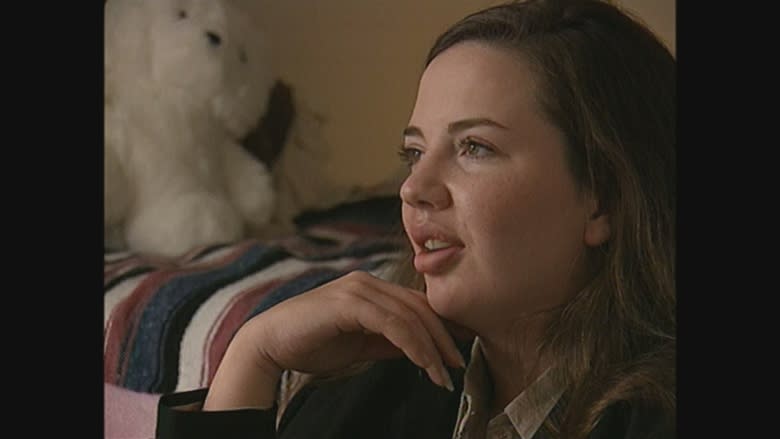After decades of silence, Canada's one-time most dangerous woman slams justice system
Lisa Neve was once labelled the most dangerous woman in Canada.
Today she's speaking out about a justice system that nearly sent her away for life, a system with a rising number of Indigenous women behind bars, a system facing a mental-health crisis with more dangerous offenders than at any time in history.
Neve was just the second woman in the country to be declared a dangerous offender in 1994, a designation intended to be reserved for the most violent criminals and sexual offenders. At 21, she expected to spend the rest of her life in prison on an indefinite sentence.
This week, she spoke to journalists for the first time since 1999, the year her designation was overturned and she walked away from the criminal justice system.
"I'm not Canada's most dangerous woman," she said, clutching the hand of her partner, Michael Marcovitch, a criminal defence lawyer in Stony Plain. "I'm Lisa Neve. I'm a sister, a partner, a friend."
Neve testified in Edmonton Tuesday before the Senate Committee on Human Rights, which is studying human rights in Canadian prisons.
"I want people to know that you can't take away someone's whole life and tell them that they're unredeemable at 21 years old," she said.
Born in Saskatchewan on Boxing Day in 1972 to a Métis mother, Neve was three months old when she was adopted by Jim and Colleen Neve.
Her early childhood was unremarkable, blending into the suburban landscape of Calgary in the late 1970s.
At age 12, Neve was caught drinking at school with four friends. When the police came, she refused to go home for fear of getting grounded, so they put her in handcuffs and took her to a children services centre, where she said she was forcibly strip searched.
Frustrated when other girls at the centre bullied her, Neve said she hit the most hostile girl over the head with a metal bowl and wound up in a court-ordered mental health treatment program.
"Nobody wanted to help me. They just wanted to control me," she said.
3 years in custody
Neve said she started running away from care facilities and got caught up in drugs and prostitution.
The better part of her teen years were spent filing between children services' agencies, psychiatric care and youth corrections facilities across the province. Between age 15 and 18, she was out of custody for just four months.
"I got involved in prostitution and drugs and I wanted so bad to go home, but it was too late," she wrote in a 2005 book, co-authored with now-Senator Kim Pate, a longtime advocate for prisoners' rights who sits on the committee.
"Maybe things would have been so much different if I was on the medication that I am on now," she wrote.
Pate has known Neve since her time in the youth system. She said in an interview that Neve's story highlights persistent problems in the federal prisons, where Indigenous women are the fastest growing population, increasing by 60 per cent in the past decade.
"She, as a young woman, was essentially underprotected but over-policed," Pate said before Tuesday's hearing.
By the time the court decided she was the most dangerous woman in Canada, Neve had been convicted 22 times. Her crimes ranged from petty theft to carrying a knife while working on the street, and taking hostages in two separate incidents while in youth custody.
Neve once testified at trial against an abusive pimp who was convicted on assault charges. The cross-examination was particularly ruthless, Neve said, when defence lawyer Sterling Sanderman — now a Court of Queen's Bench justice — brought up her history of prostitution.
Shaken by her experience on the stand and worried she would kill herself, Neve checked into Alberta Hospital. When the doctors asked why she was there, Neve said she wanted to kill the defence lawyer and his family.
A few days later, she was charged with two counts of uttering threats. She was later convicted.
Eventually, she was designated a dangerous offender during a sentencing hearing for a robbery conviction. Psychiatrists called her a psychopath and "the female equivalent of a male lust murderer," though she had never killed anyone.
'Hearing that is shocking'
Her sentence, the judge told her, would expire at the time of her death.
"Nothing can prepare you for that," Neve said. "Just hearing that is shocking. I think my sentencing was the hardest thing I've been through."
Edmonton lawyer Brian Beresh took Neve's case on appeal. He remembers the inconsistencies between her criminal record and the woman who was depicted in court during the hearing.
"In my view, the decision was almost entirely based on the psychiatric evidence of one psychiatrist," Beresh said on Wednesday. "More importantly, at that age, this is an indictment against any chance of rehabilitation."
Neve spent most of the next three years in maximum-security facilities, in what critics have called conditions of segregation in small, isolated units. She routinely self-harmed and her mental health deteriorated. She was diagnosed with schizophrenia in 1997.
"In prison, her mental health issues were seen as symptomatic of her criminal label," Pate said, "that her behaviour was 'bad behaviour.'"
Before and after medication
Neve now divides her life into the time before medication, and the time after.
"I was put on clozapine, and I haven't had any problems," she said. "I go A.C., B.C. — after clozapine and before clozapine."
After the diagnosis, Neve got her security classification lowered and was transferred to the Okimaw Ohci Healing Lodge on the Nekaneet First Nation in Saskatchewan, a corrections facility rooted in the community's healing practices.
A recent study found that nearly 80 per cent of women in federal corrections met the criteria for a mental disorder. The number jumps to more than 90 per cent among Indigenous women, though the Correctional Investigator has pointed out there are no standalone treatment facilities for women in federal corrections, who are rarely transferred to psychiatric hospitals.
In 1999, after a 15-month investigation into the case, a panel of three Appeal Court justices found it was "not reasonable" for Neve to be ruled a dangerous offender. Given her short criminal record of violence, the court found a young woman drifting from one set of traumatic circumstances to another.
Neve was 26 when she was released on July 1, 1999, days after the designation was overturned. She had served six years for a robbery the appeal court said typically carries a three-year sentence.
A young life painstakingly documented by the courts and the media vanished from the public record and faded into private life. It's perhaps not surprising, then, that Neve was less than keen to talk about the past two decades of her life.
She swims and takes courses with the Canadian Mental Health Association, she said.
Some were skeptical when Neve was released, convinced it was only a matter of time before she would re-offend. Beresh said Neve has proven she's anything but a dangerous offender.
'A scary move'
"I think it's a real indictment for those who do not sincerely believe that rehabilitation is an important element of our justice system," he said.
In the past decade, 375 people have been deemed dangerous offenders, nearly the same number of designations as were handed down in the 30 years before that.
"I think it's a scary move," Beresh said. "The use of the legislation shows a weakness in our system. It is essentially saying we have no other solution. I think that's pathetic for a criminal justice system that holds itself in such high esteem."
There are currently four women with dangerous offender designations, according to the latest Corrections Canada data from 2015-16.
"For a dangerous offender you have to prove it, you can't just say at 21 years old you're never going to change," Neve said. "It's got to stop. It's got to stop now."
Her story is still instructive today, Pate said, given that the same risk assessment tools used by corrections to put Neve at a higher security classification are still in place today.
"The fact that when she was able to obtain the support of the mental health system and get out from under the criminal justice system, that she'd never look back is emblematic of what could and should happen for many other individuals who are in the system now who have mental health issues," she said.
As Neve stood in the glow of the camera lights this week, she called herself a survivor.
"Things that I went through, maybe it'll make someone think, 'I shouldn't give up on my child," she said. " 'I shouldn't give up on my friend. I shouldn't give up on my mother or father,' whoever's in their life that's in crisis.'
"I want people to know that no matter how dark it is, there's always a shining light. That's what happened to me."






